Tender lefse with winter chanterelles, sauerkraut and Swedish cheese is a sort of mushroom burrito from another dimension you have to try.
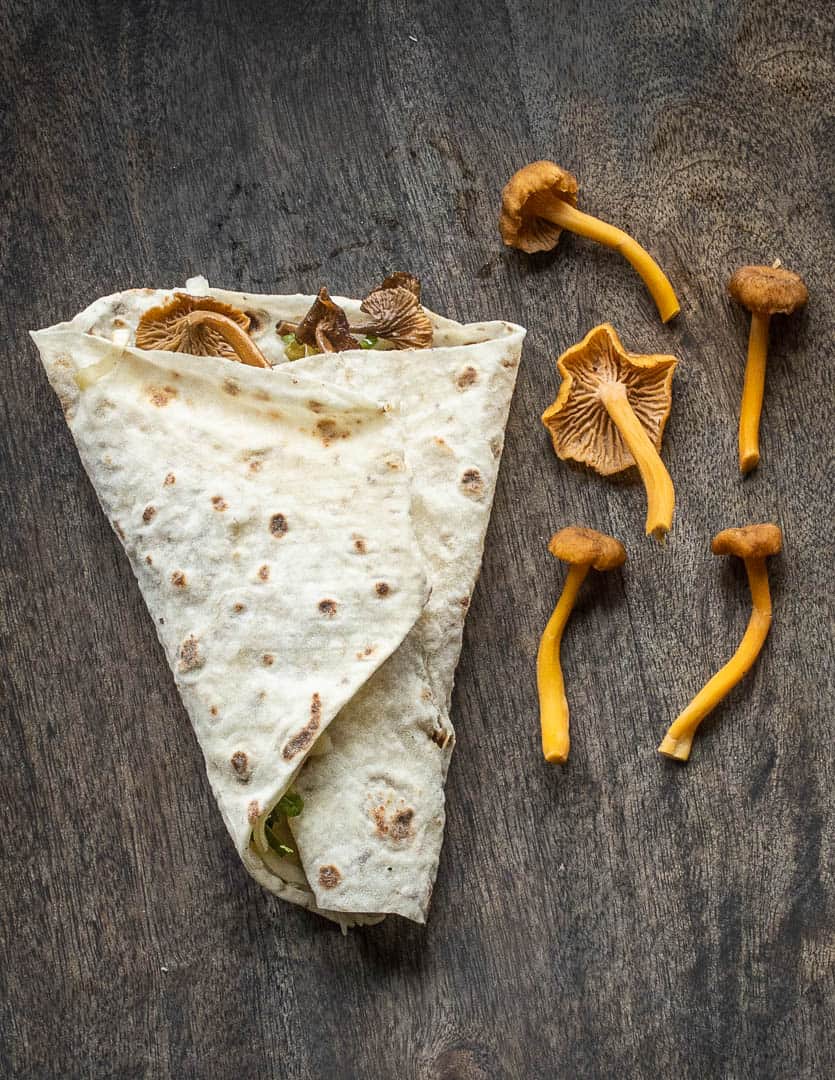
When I think of the cuisine of my Nordic ancestors, I don't usually think of mushrooms, and that's a mistake. Scandinavia is home to many similar varieties of mushrooms that we have in the Midwest: chanterelles, murklor, and even matsutake!
Lefse with chanterelles, sauerkraut, and hushallsost cheese is one of the most delicious examples of Nordic mycophagy I've seen yet, and a culinary birthright I didn't know I was missing.
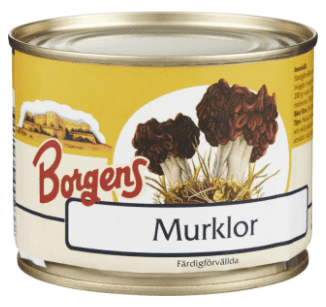
My journals are filled with ideas and little notes gleaned from all kinds of places though, and one day, watching a show on Swedish food (for the life of me I can't remember which one) I noticed some delicious yellowfoot mushroom wraps getting served up from the Nordic Food Truck.
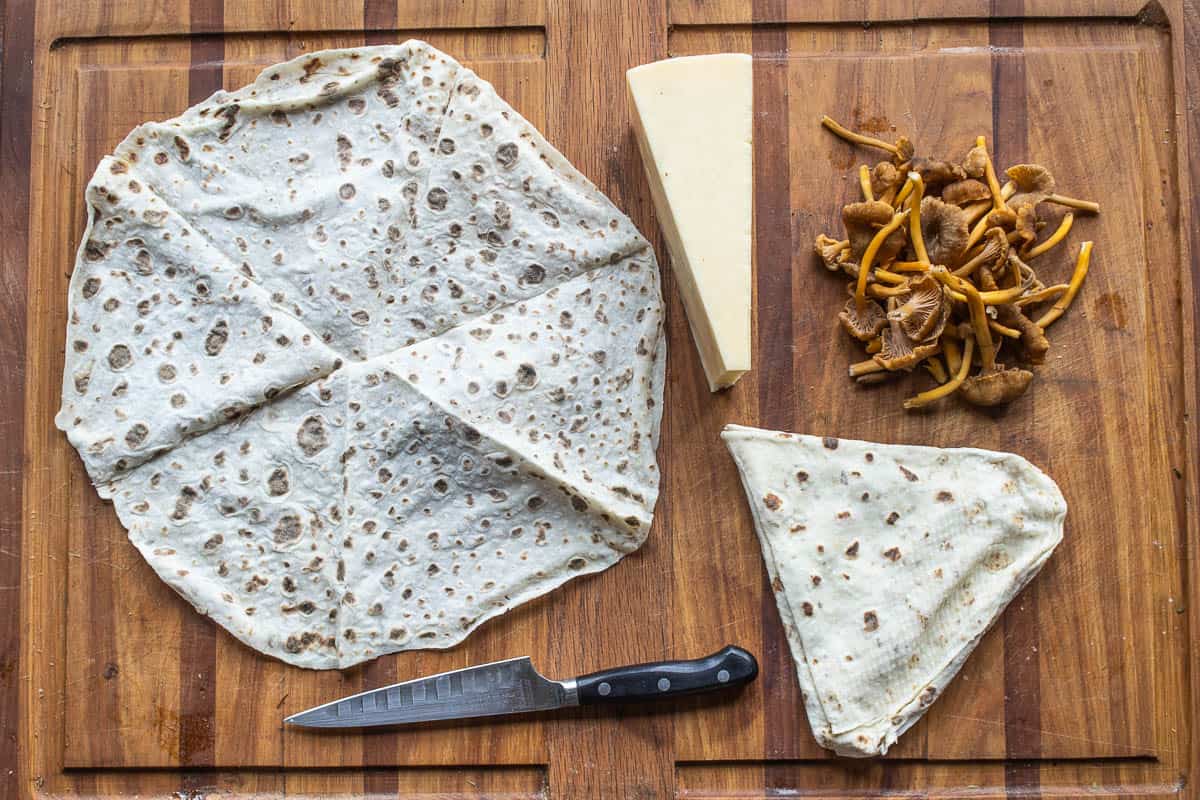
A worker in the truck was cooking mushrooms and sauerkraut on a flattop grill, turning them over with a spatula, and folding them into a sheet of tunnbröd (soft flatbread, I use lefse here since It's more available) lined with soft, melting Swedish cheese (Västerbottensost).
The show moved quickly, and I remember having to rewind it to make sure of what I was seeing, but after a re-wind, I could definitely see that the mushrooms were yellowfoot chanterelles, a delicious mushroom that seems to perpetually live in the shadow of it's famous, chunkier cousin, the golden chanterelle, or kanterelle, as it's known.
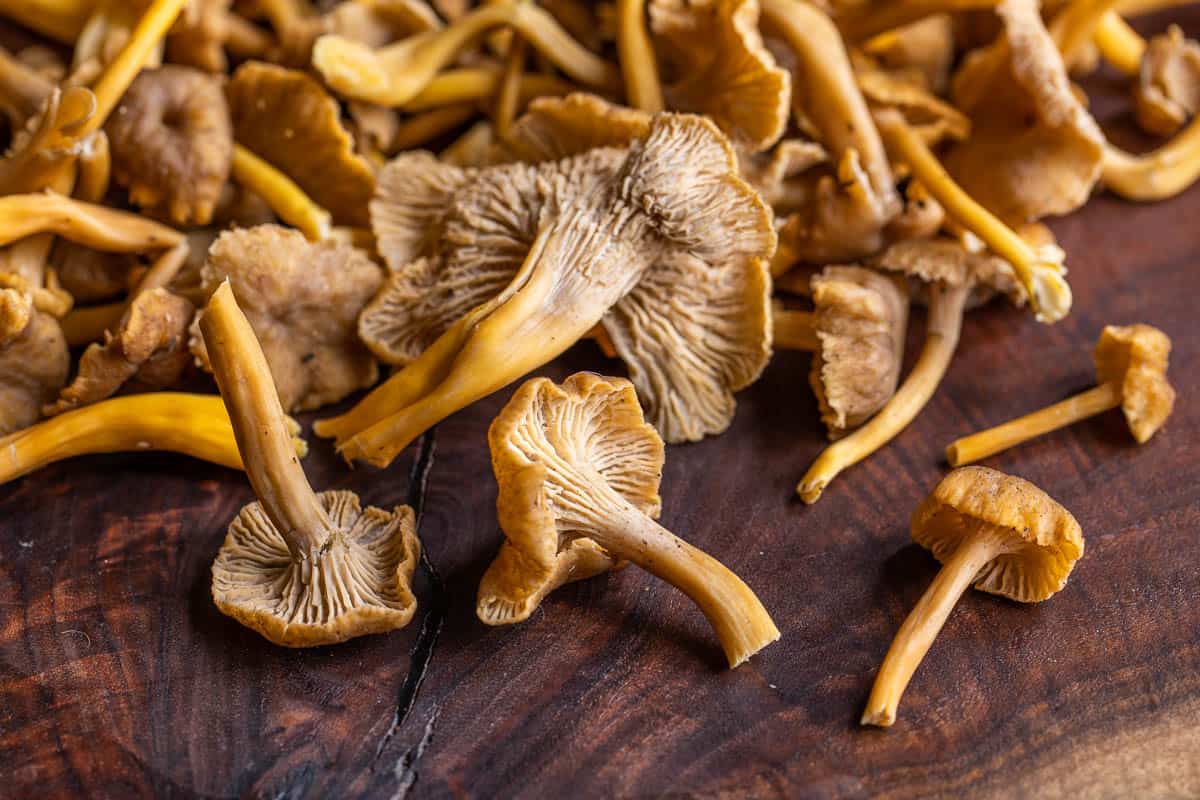
Kanterelle, Chanterelle, Cantharellus
In Sweden, winter chanterelles (Craterellus tubaeformis or something very close to it should be what they have in quantity) are known as "Trattkanterelle", tratt meaning funnel, and kanterelle a cognate of chanterelle.
These are, for all culinary intents and purposes, identical to the yellowfoot chanterelles sold commercially in the United States out of the Pacific Northwest.
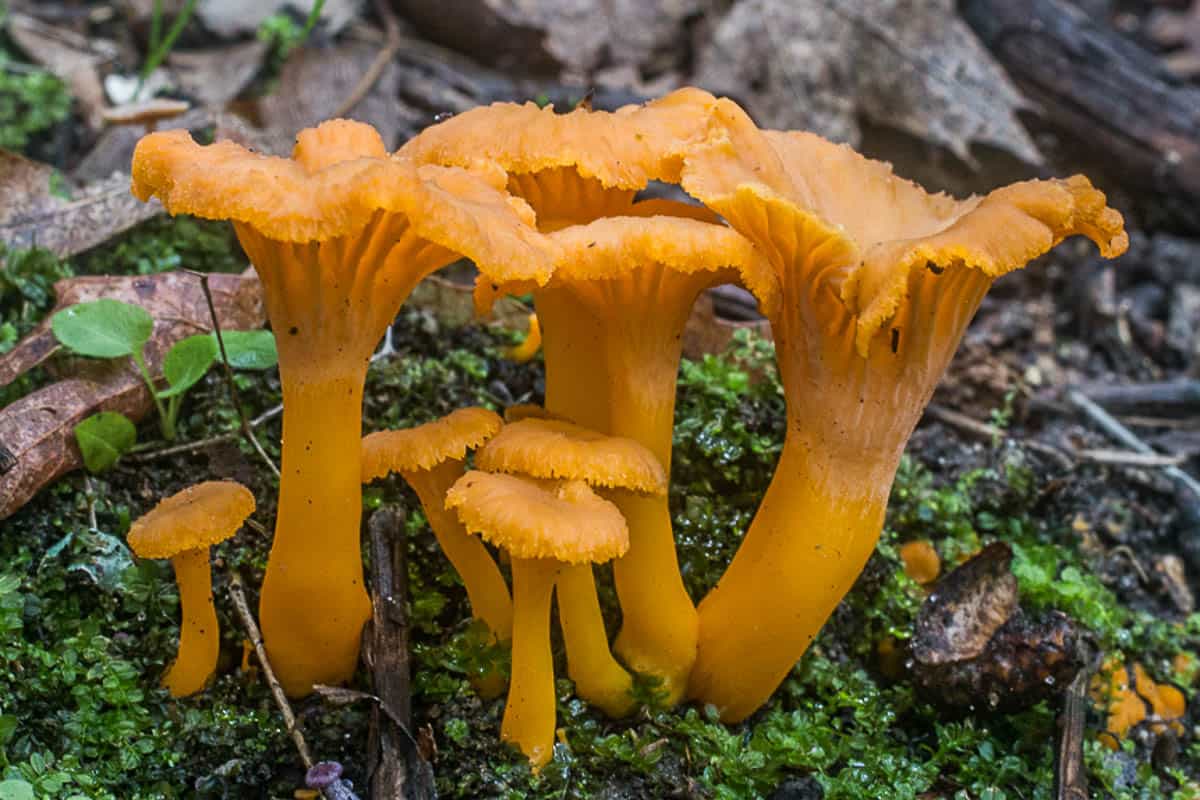
C. tubaeformis are the largest, meatiest yellowfeet I've eaten, with the ones I harvest locally generally being smaller (I assume they're Craterellus ignicolor with their brilliant yellow-orange color and small stature) although they make up for it with a great flavor.

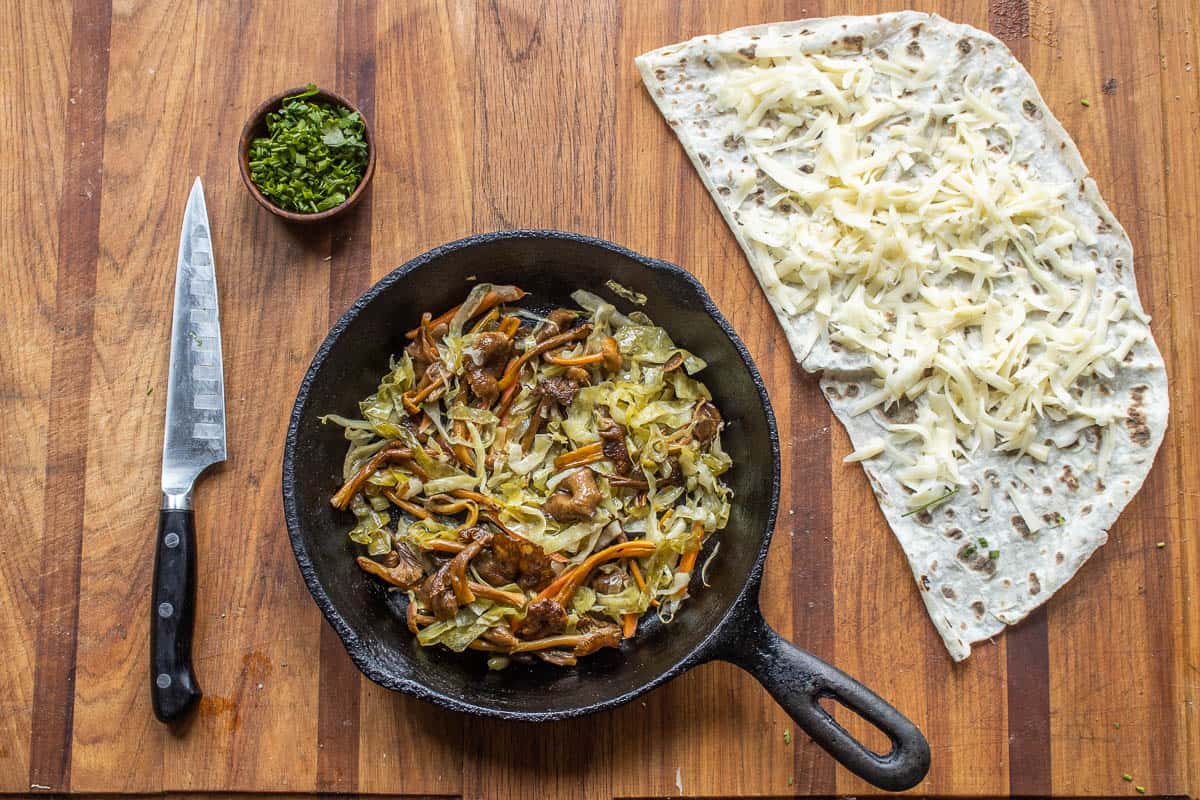
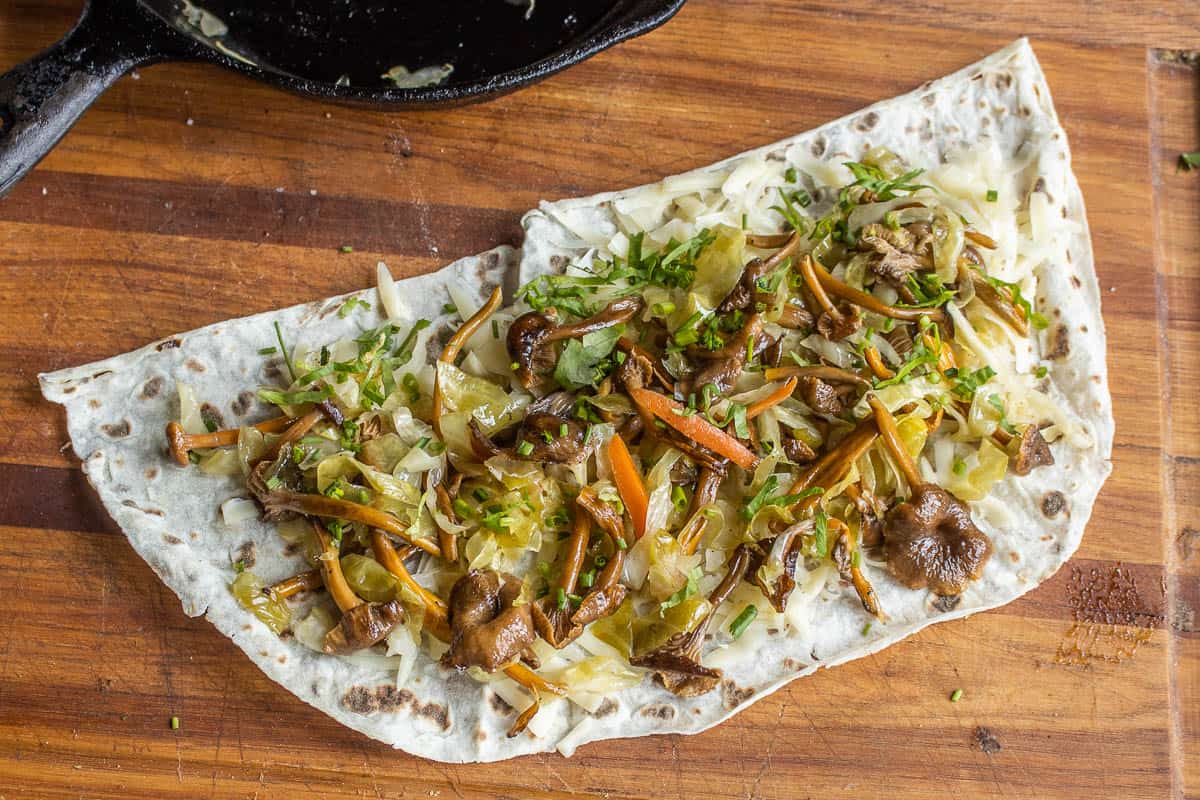
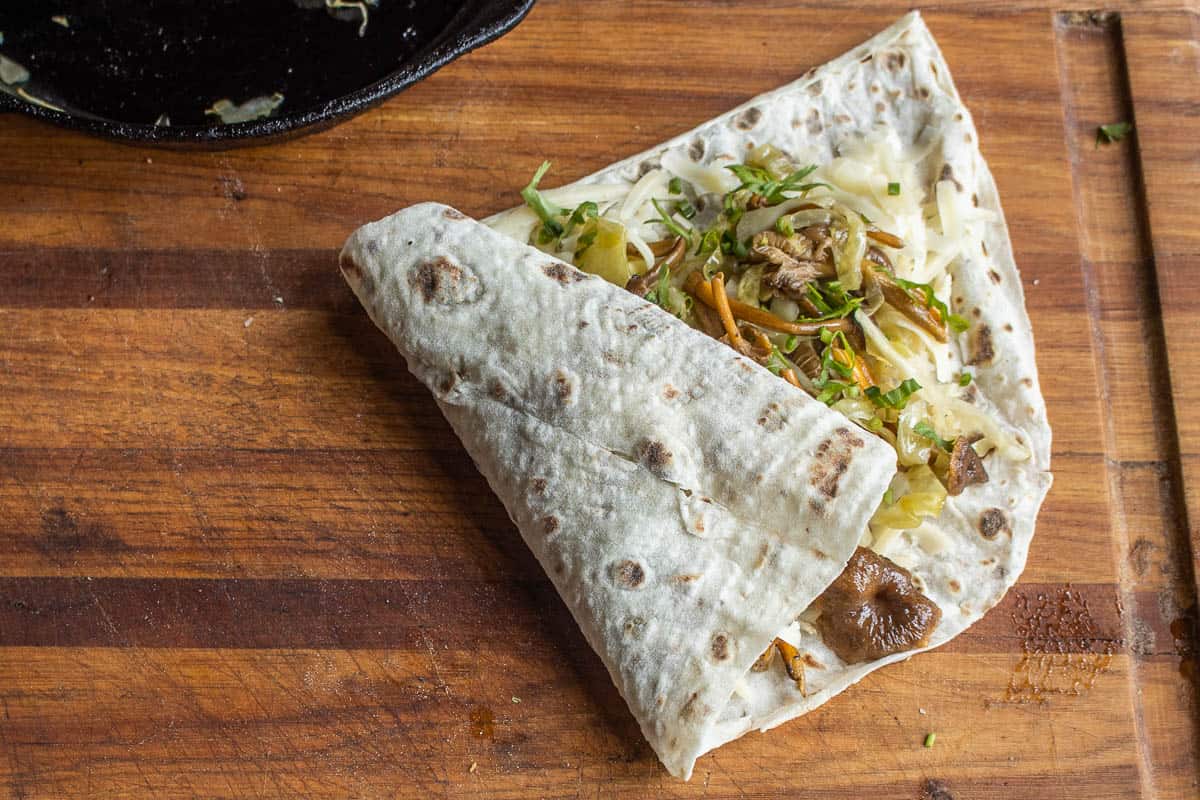
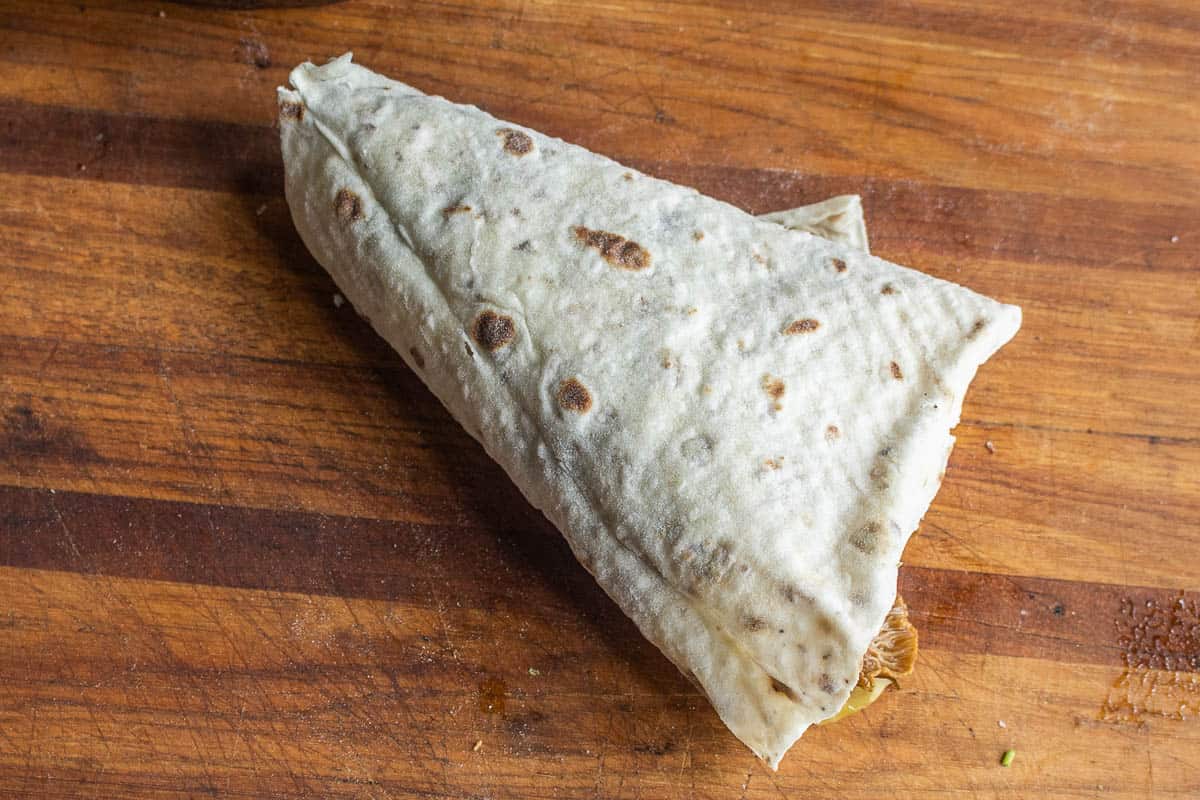
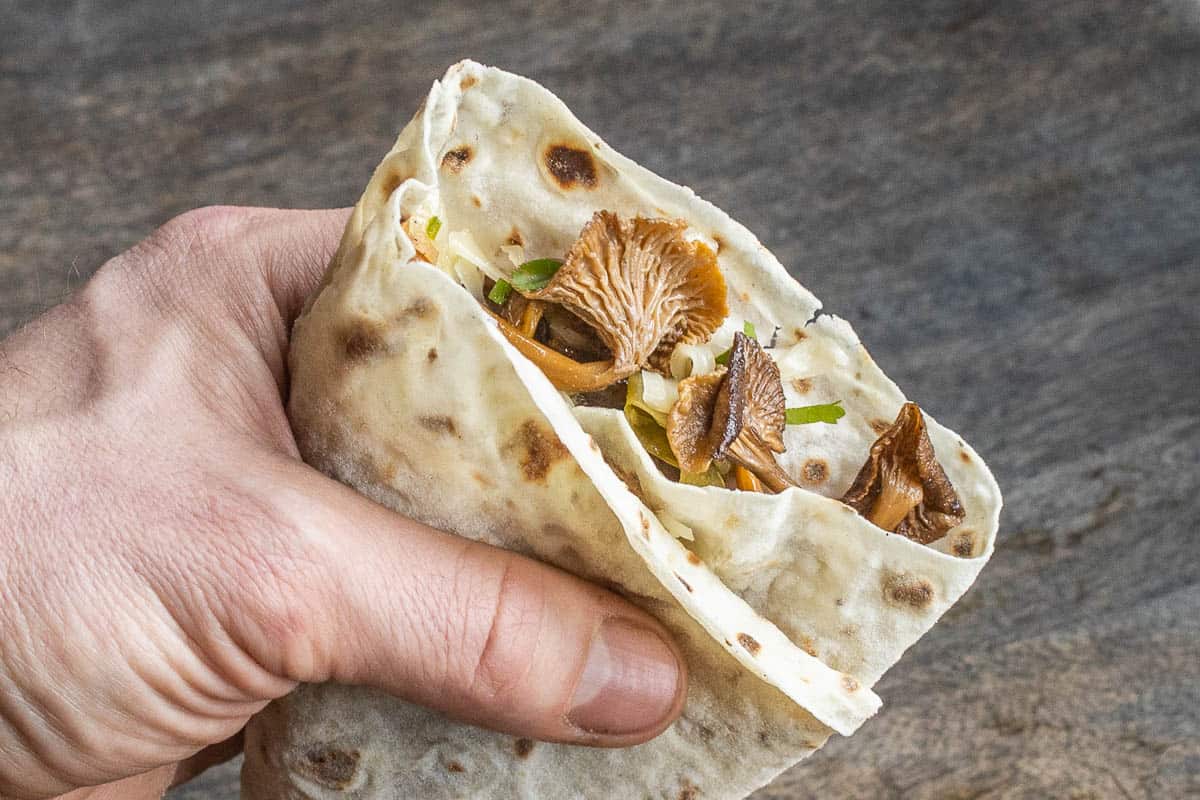
A heretical substitute
After I devoured my first Swedish yellowfoot burrito, I had to share it with someone, anyone, as soon as possible while I still had the lefse. It was too delicious to keep to myself.
I called my Grandma and Grandpa and asked if I could stop by with a snack, packed my things up, and drove on over. As I unpacked, pontificating about how delicious it was, I realized with some embarrassment, that I'd forgotten the lefse (Insert ringing of the shame bell).
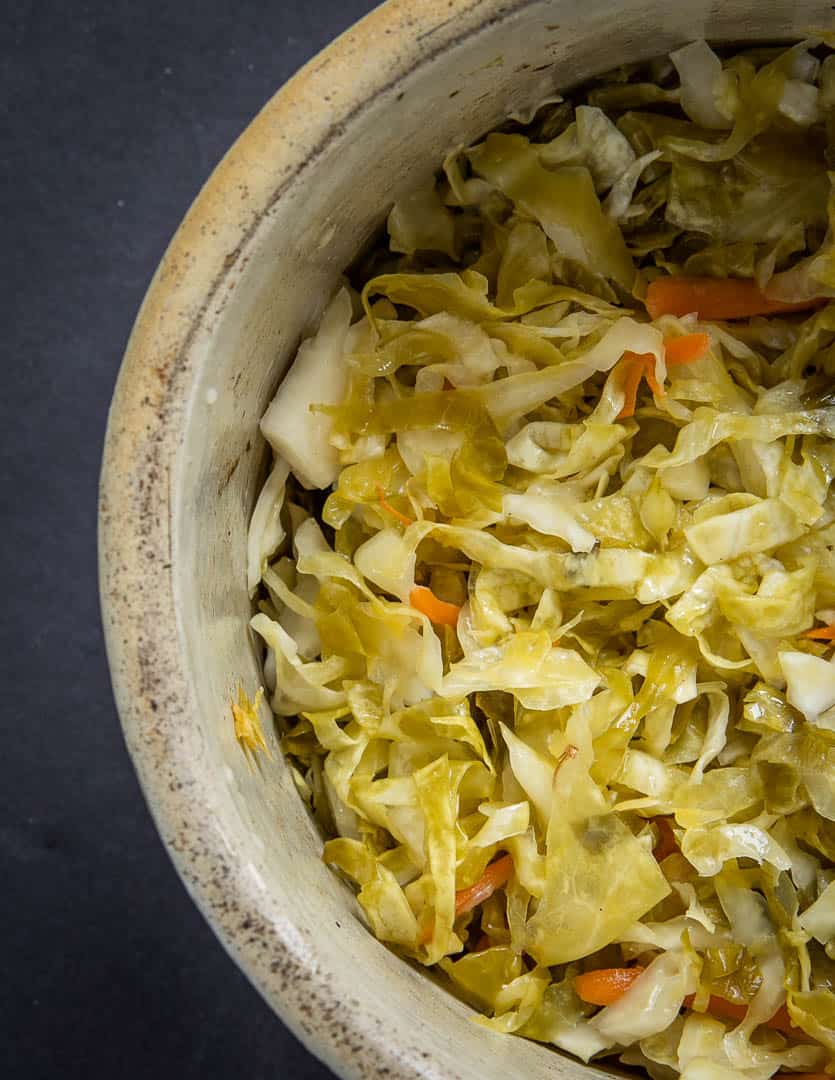
Grudgingly, I accepted Grandmas offer of flour tortillas to take their place. Now, I'm not saying you should skip the lefse, this little mushroom burrito is so good it's worth breaking out the lefse mat and turning sticks just to taste it (or buying some from your local grocery store).
But, if push comes to shove, a thin, warm flour tortilla can work in a pinch. Lefse is lighter, and more delicate than a clunky tortilla though, and the two are completely different products, so it's a concession.
Hunting lefse
In Minnesota and Wisconsin, Lefse is sold at all kinds of grocery stores, but, if you have the chance, it's worth heading over to one of the most iconic of Scandinavian food markets our region has to offer: Ingebretsens.
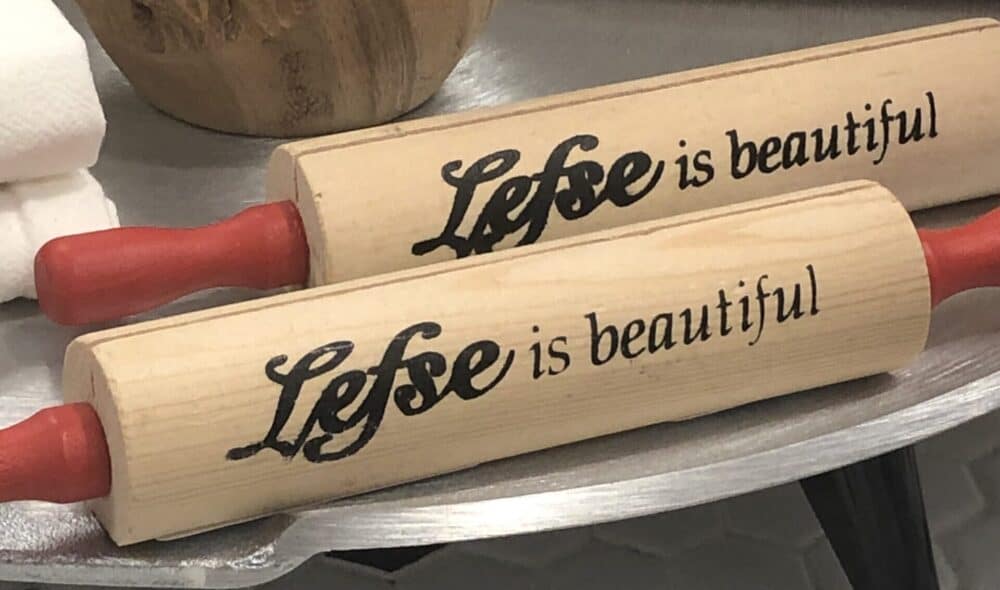

Not only does Ingebretsens make their own lefse, but they also have homemade fenelar (a smoked mutton ham), homemade blood sausage, salted pork trotters, and cloudberry preserves.
Of course, there's also the miniature trolls and crafts painted with the delicate Rosemåling technique all over that always reminds me of my Grandmother, and family time making rosette cookies and krumkake filled with whipped cream.
Using Different Mushrooms
I use winter chanterelles here, but any thin, delicate related mushroom would be good. Black trumpet mushrooms and small cinnabar chanterelles would be great too. Sliced Hedgehog mushrooms and cauliflower mushrooms are both in season at the same time and could work too.
More
If you like this, make sure you also try Winter Chanterelle Broth with Pasta, it's one of my favorite winter chanterelle recipes.

Winter Chanterelle Lefse With Sauerkraut and Cheese
Equipment
- 1 10 inch saute pan
- 1 baking sheet
Ingredients
- 2 sheets of lefse
- 10 oz fresh yellowfoot chanterelle mushrooms
- 6 oz grated Swedish cheese a melting variety like Hushallsost or Brunost (very mild fontina can be substituted) at room temperature
- 8 oz homemade sauerkraut if you’re sensitive to salt, rinse and pat dry. Canned sauerkraut should not be substituted.
- 4 Tbsp sour cream full fat, always
- 4 tablespoons unsalted butter
- Fresh cracked black pepper
- Chopped fresh dill or cilantro, chives, or a combination
Instructions
- Preheat the oven to 300F.
- Sweat the mushrooms in the butter until wilted, and aromatic. Add the sauerkraut to the mushrooms and heat through.
- Meanwhile, cut each sheet of lefse in half, arranging the slices on a large baking sheet. Spread each slice with sour cream, then divide the cheese evenly over the slices of lefse.
- Turn the heat on the mushrooms and sauerkraut to high (again, don’t allow it to brown, you just want it hot enough to melt the cheese). Remove the pan from the heat, and stir in the herbs.
- With tongs, evenly divide the mushroom-sauerkraut mixture between the four sheets of lefse.
- Fold each sheet of lefse up in ⅓rds to make a sort of rustic, flat cone, then heat in the oven for a couple minutes to ensure the cheese melts.
- For the real street-food feel, wrap the finished warm lefse sandwiches in parchment.
- Serve with ice cold Carlsburg or Pilsner Urquell (probably the closest thing you can get in the States to a Swedish lager)
Notes
Lefse Substitutes
I love the lefse here, but you may not be able to find any at your local grocer. If you can't, any sort of thin, wrap-able flatbread will work. You can even use a flour tortilla if you can't find anything else.Nutrition
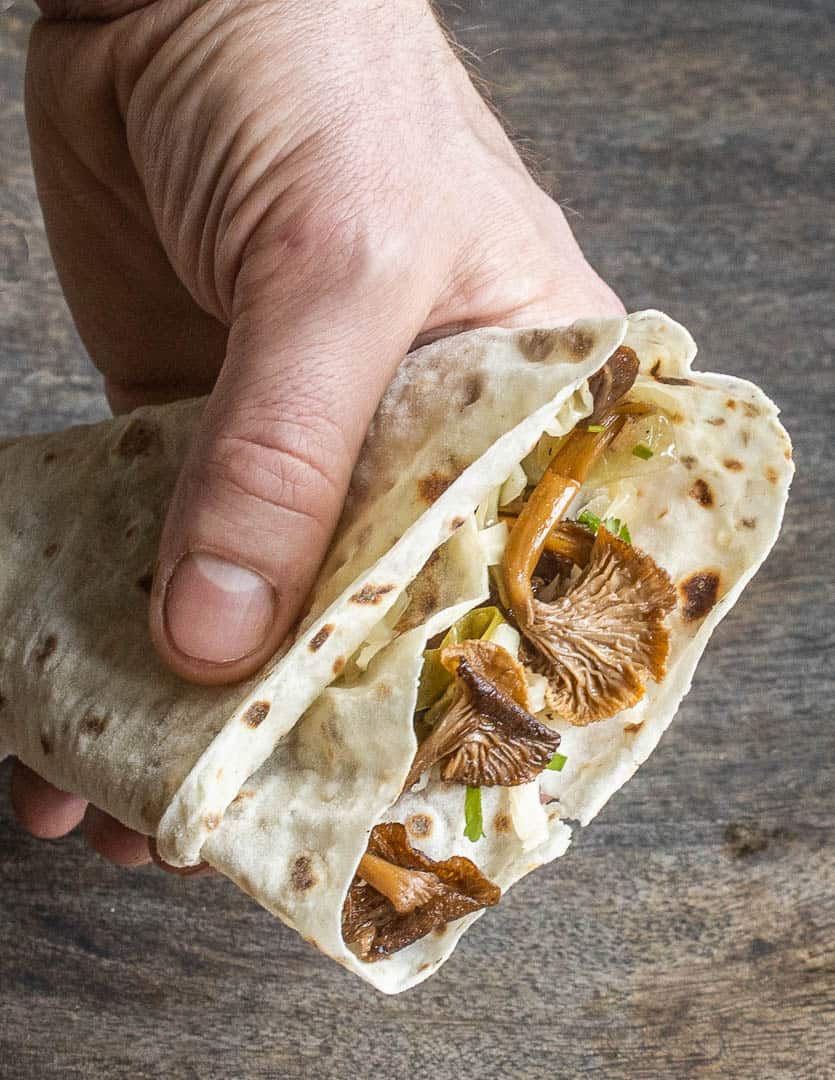

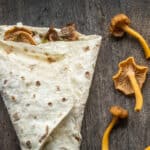
Lauri Shemwell
A mouth full of wonderfulness! Thank you so much for sharing this delightful recipe!
I couldn't find Lefsa so used what I had on hand: 6" white flour tortillas, German sauerkraut in a jar, and Farmers Cheese. For the two of us I cut the recipe in half. The tortillas were so full I could only fold once. I brushed the outside with the butter from the mushrooms (I cooked the kraut separately as I had already thrown it in a pan out of habit) then grilled on the stove top until browned and the cheese had melted. Served with a bratwurst, side salad, and red wine. These were so delicious that both my husband and I felt like we could have eaten two and ignored the brat and salad. The flavors meld together in perfect unity. Wish I could post a picture with the comment.
You have definitely influenced meals in our home by sharing your foraging knowledge, skills, and creativity, for which I am grateful. Blessings to you and yours!
P.S. I am tempted to make another for lunch today!
Alan Bergo
Thanks Lauri, yes I just love this one.
Erika P
This sounds amazing! I’ve been lucky enough to experience picking chanterelles in Sweden and eating tunnbrödesrullen from a food truck in Stockholm. Now I live in a forest in Georgia with an abundance of different types of chanterelles. I’m in heaven! Where can I find your sauerkraut recipe?
Alan Bergo
Mix sliced cabbage with 3% of it's weight in salt and ferment for 2 weeks.
Velma Sterenberg
Hi Colette and Alan
My 2cents worth on the Gyromitra esculenta. One of my fungi buddies is originally from the Bancroft area of Ontario and they boiled their Gyromitra before eating and/or pickling. They also ensured that they did not inhale any of the steam while fungi were boiling! Mycophiles from Eastern Europe have also cautioned me about not inhaling the steam. Perhaps it's just an abundance of caution.
Colette, not sure where you live in Quebec, but if at a similar latitude to Bancroft, you might want to have someone properly I.D. the Gyromitra species you are finding and go from there.
Alan, apologies for using your website for fungi discussion. Was great to learn about the variation in MMH in different species of Gyromitra. We have several variations here, but never tried them. Must find that lefse recipe.
Alan Bergo
Thanks Velma, I'm the one that mentioned the murklor. I brought it on myself 🙂
Irina
I wonder how you make the sauerkraut? Because in order to make it properly one need the right type of cabbage, i.e late season varieties that will turn to a nice white color later in the fall. The best ones left on the field for after the first frost, so that the cold snap transforms the starches into sugars.. Hence good natural fermentation due to higher sugar concentration, crispy crunchy sauerkraut which retains its white color. The cabbage that sold in regular grocery stores is usually summer varieties of green color. They are good for soups and stews but too dry for fermenting. I have a few friends who tried to make sauerkraut from that type cabbage and it was a failure - not enough juice produced to get good fermentation going even with a lot of weight to compress the shredded cabbage.
Alan Bergo
Hi Irina.
So, I've fermented many, many different varieties of cabbage--ever single one I've ever come across at one point or another, and I can assure you, without a doubt, that every single cabbage on Earth will ferment into sauerkraut just fine. Many things we eat do concentrate sugars when they're exposed to low temperatures, but such minute increases in natural sugars will have a near imperceptible effect on the finished ferment after fermentation is complete.
Common green cabbage from a supermarket purchased at any point in the year will always have a lower water content than something like napa cabbage, or Savoy cabbage, but, if someone has a problem turning that into kraut, it is due to user error, or some unfortunate environmental circumstances like drastic fluctuations in temperature at the beginning of the fermentation process.
Common green cabbage is dry, which is why most older recipes will instruct the cook to pound the cabbage with a mallet to speed up the maceration process that draws out the water. If, for some reason a vegetable doesn't have enough natural water to cover itself with brine, you would add brine to it, which would negate the problem. You can also ferment regular green cabbage by mixing it after slicing with 2% of it's weight in salt and vacuum sealing it too, without any pounding at all, which illustrates that it's more important that the lactobacillus bacteria have a happy anaerobic environment in the beginning than a big meal of sugar.
Irina
Sure, any vegetable or fruit can be fermented. It is only a question of the quality of the final product. It is hard to beat the crunchy kraut that burst with mildly pungent, flavorful and not very sour juice once you start to chew it. It can be used as a side dish or salad if dressed with olive oil and a bit of diced raw onion or scallions For that kraut the juicy crunchy leaves of late cabbage are the best. And I am talking only about regular cabbage, not Savoy or any Chinese varieties.
We used to make sauerkraut according to the recipe passed on in our family with Russian heritage. For that one has to pick not necessarily large but heavy heads of cabbage with preferably white leaves. Chop it neatly, if desired add shredded carrots (this variation with carrots always looks good in salads), add salt and mince by hand all together to soften the cabbage. Again if the leaves are juicy there is no necessity to use the mallet. Then the mix is packed really tight, layer by layer tamped down into a large vessel like a small barrel, large enameled stock pot, etc. By the time all is packed the juice may be already visible. To ensure that the juice is squeezed out and cover the top to create an air lock. a disc of some sort ( like a plate or wooden disc wrapped in plastic) placed on top surface of the cabbage and heavy weight (rock(s)) goes on top of that disc. Good cabbage will produce enough juice to cover the surface with an inch of liquid. The whole thing left at room temperature to ferment. In the first 24 hours usually not much is happening visually. In reality the fermentation started via aerobic pathway from the oxygen that is trapped there and the sugars from the cabbage. Considering that there are 5g of sugars per 100g of cabbage (approximately half of it glucose and the other half is fructose) it is a good start for initiating the fermentation. There are also approx 5-6 grams of carbs in cabbage, If some of them inverted into sugars due to cold (frost) temperature it is even better. Once this phase of fermentation is ongoing it creates an environment favorable for anaerobic bacteria to continue the fermentation process. Depending on the ambient temperature and the size of the container the process can take a few days, up to a week. Every day we used to poke few holes all the way to the bottom of the container to release trapped gases (not pleasant smelling, due to sulfur present in cabbage) which are the product of fermentation and also indicator of how it is progressing. It has to be stopped at the right moment when the cabbage already sour enough to be able stay preserved, still crunchy but not overly fermented, which produces very sour and limply/soft kraut. At that point we would transfer kraut in smaller and more manageable size containers (like glass jars) to store in refrigerator or other very cold places just above freezing. Low temperatures will stop fermentation substantially, but after long storage one can notice the difference in taste and texture. And that is why by the end of winter the last batches of sauerkraut were used for soups and stews. That is classic approach to making sauerkraut in my opinion. And I used it with the cabbage I was able to find sometimes at the stores or at the farmer markets back in Ontario, Canada. Since we moved to Virginia, US it is practically impossible to find the late fall cabbage. The climate obviously is not favorable for that kind of cabbage. I do find in grocery stores German style sauerkraut in glass jars that is actually have 3 ingredient: cabbage, water and salt. It is limply, soft and over fermented one, but it is suitable for soups and stews.
Just a thought may be off the track, but related to our food preferences. It is amazing how much supermarket culture changed what is grown on the fields and how quickly it happened, essentially in our lifetime.
.
ViolaBlue
I absolutely LOVE this article! In exploring my Scandinavian heritage I took a number of Scandinavian cooking classes at the North House Folk School. Lefse making was one of them, so I know how tender and lovely handmade lefse is. The potatoes add such an amazing quality. Then making them up with Swedish cheese, yellow footed chanterelles, and sauerkraut...that's divine!
Alan Bergo
Thanks Viola.
Louise
I am half Norwegian, and my grandparents never ate mushrooms. I found a lefse recipe, gluten-free and will be eager to try this. I also have chantelles, dehydrated. Thanks.
Alan Bergo
Ooooh now I will be googling GF lefse. Thank you! I would only use fresh mushrooms for this though. The yellowfeet pictured here are fruiting now in the PNW.
Colette Baribeau
Quite surprising that gyromit esculanta est edible because it contains
monométhylhydrazine (MMH)
which is toxic on long terme.
At least, here in Québec...
Alan Bergo
Hi Colette. There's a lot of misinformation about the genus Gyromitra. I would invite you to take a look at the post I linked to, since I was anticipating comments and questions about Gyromitras that innevitably come my way. Here's the skinny.
Gyromitra esculenta is safe to consume when thoroughly boiled, since the MMH is water-soluble and released by heat (this is an over-simplification of the process). Even the epithet suggests that the mushroom is edible (esculent) just like Morchella esculenta, which we can all agree is definitely edible.
Every culture that consumes Gyromitra knows that the mushroom must be either dried or boiled before consuming, (always cooked after drying) and warnings are often posted next to the mushrooms in their fresh state in markets. The real kicker though, and what changed my mind about eating them, is that the concentration of MMH varies drastically within the genus. Gyromitra montana and G. caroliniana are regularly cooked without boiling, since the MMH concentration is negligible. My local Gyromitra korfii, which you probably have up there in Quebec too, should have a similar lack of MMH along the lines of those two mushrooms.
Even so, it's interesting to think about the fact that Gyromitra esculenta is probably the most widely consumed mushroom in the genus around the world, as well as being the "most dangerous". It's all about if the mushrooms are properly prepared before consumption. Cassava is poisonous too, along with nutmeg and cinnamon, if taken in the right doses. Hope that helps. A
Lisa
Just needed to pipe up and say that DRYING Gyromitra esculenta is not a way to deactivate the toxin. It might degrade it a bit, but drying alone is not a safe way to prepare them.
My local mushroom group was trying to find a way to get MMH levels measured in G. esculenta, but so far it's turned out to be prohibitively expensive.
Alan Bergo
Lisa, sure, but the question of if concentrations of MMH are brought to safe levels by dehydrating alone is a bit of a moot point here as dried mushrooms aren't consumed raw. I did see how my comment could have been misconstrued by someone very unfamiliar with mushrooms though, so I adjusted it. Thx